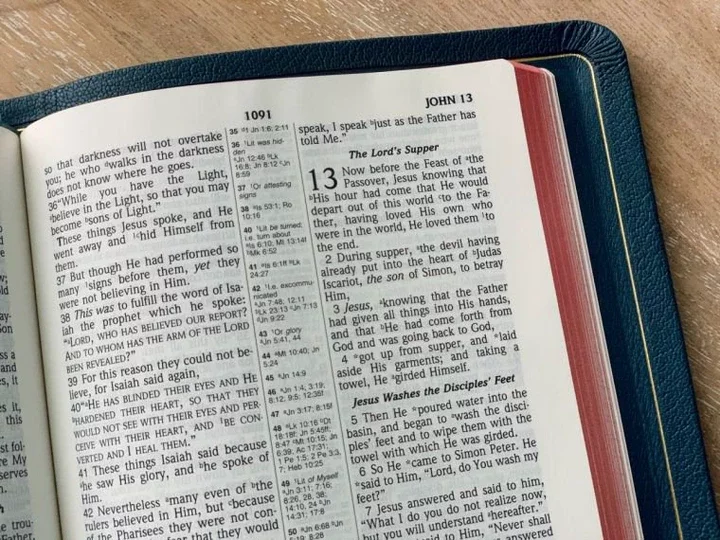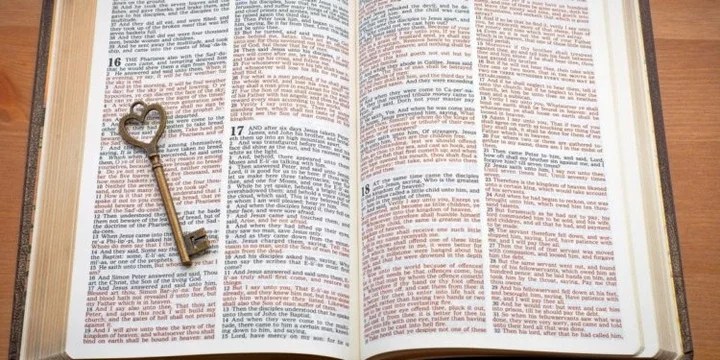
The New Testament consists of 27 books. The story of how we got the order we have today is very interesting, and it affects how we engage with it. This is the story ...
Order of the Bible
We are used to the order of the books of the Bible, which range from Genesis to Revelation. The Bible is not a single book as such, but more of a compendium of constituent books - or a library. Their traditional order is not strictly chronological, nor are they ordered according to importance. The Bible can, and has been, ordered in many ways. The standardisation of the order came about when the earliest books, called codices, were created. When the books of the Hebrew Scriptures were each kept on a separate scroll in the synagogue there was no real official order for all of them. An order had to be decided once they were placed consecutively in a codex.
Alphabetical order
If you access a Bible via the popular YouVersion app, you can choose to sort the books of your Bible by 'Traditional' or 'Alphabetical' order. When the books of the Bible are sorted alphabetically, they go from Acts to Zephaniah, and the New Testament goes from Acts to Titus. The alphabetical order will vary from language to language, and it is not very useful theologically, but can be very useful if you are not used to the traditional order of the books. Some Bibles come with a contents page at the front, with the books listed alphabetically and a page number for the first page of each book. An alphabetical list can be very helpful if you really don't know where to find Job, Nahum or Titus. The reality is that the order that the books of the New Testament are put in is down to historical tradition.
History of the order
The Bible starts with the creation narratives and the origin stories of Israel, followed by the historical books of the kings and chronicles. The Old Testament is in roughly chronological order but in many of the books the timelines overlap.
In a similar way, the New Testament starts with the stories of Jesus followed by the Acts of the Apostles. The Old Testament then has the stories of the prophets, and likewise the New Testament has the writings of the apostles. Placing the core story with the first five books Matthew, Mark, Luke, John and Acts at the start, echoed the placing of the five Books of Moses also called the Pentateuch, at the start of the Jewish Scriptures.
After the first five books of the New Testament, the rest of the books are not really books at all, but letters known traditionally as epistles. These are usually grouped as the letters by St Paul and then the letters by other apostles.
St Paul's letters
The letters traditionally ascribed to St Paul, are also called the Pauline Epistles (not because they were written by a woman called Pauline, but because Pauline is the adjectival form of the name Paul). These are clustered into two groups: the letters to the churches and then the pastoral letters.
Epistles to the churches
The first group of letters from Paul were written to church congregations around the eastern Mediterranean. So there is the letter to the churches in Rome, in Corinth, in the province of Galatia, in Ephesus, in Philippi, in Colossae, and in Thessaloniki. Sometimes books and commentaries claim that the letters to the churches were ordered in size with the longest, Romans, first to the shortest, 2 Thessalonians last, but this is only partly true because Galatians is actually shorter than Ephesians which follows it.
Pastoral epistles
The letters to the churches are followed by letters to individuals, known as the Pastoral Epistles. There are two letters to Timothy, a letter to Titus and one to Philemon, and then one to the Jewish Christians known as Hebrews, which today we might call Messianic Jews.
General Epistles
The letters written by other apostles are traditionally called the 'Catholic Epistles'. The term 'Catholic' Epistles does not mean Roman Catholic, but rather catholic in the sense of general, and so they are also sometimes called the 'General Epistles'. These are traditionally ascribed to the apostles James, Peter, John and Jude.
Traditional order
The order of the New Testament which is found in modern published Bibles is called the 'canonical' order, or if you use YouVersion the 'traditional' order. The problem with calling it the canonical or traditional order is that it is misleading. There is in fact no one single set tradition or canonical order, although those people only used to one tradition may not realise this.
Eastern and Western orders
In the Orthodox or Eastern tradition the New Testament is ordered by placing the General Epistles before St Paul's letters, so that the Epistle of St James follows Acts. However, in the Catholic or Western tradition the letters of St Paul are placed after Acts and before the General Epistles, so that the Epistle to the Romans comes after Acts.
Why the order of the epistles in the eastern and western traditions differ is debated. One idea is that for the Eastern Churches the writings of James, Peter, John and Jude took precedence over the writings of St Paul, who was admitted as an apostle later. James, Peter and John were considered the pillars of the Early Church (Galatians 2:9), with James and Jude being considered actual half-brothers of Jesus. St Peter wrote "Some of the things which Paul writes are difficult to understand" (2 Peter 3:15 NIV). The order with the General Epistles before the Pauline Epistles is an ancient order found in the fourth century Codex Vaticanus and the fifth century Codex Alexandrinus.
The Western book order goes back to the Latin Vulgate. Some people think that the Roman Church favoured the writings of St Paul over the writings of the other apostles, and so placed his letters first. However, this is also an ancient order, which is nearly the same as found in the fourth century Codex Sinaiticus.
English language Bibles
English Bibles follow the Western traditional order. The Protestant tradition came out of the Catholic tradition and has the same book order, so English Bibles (whether Catholic or Protestant) have the same book order for the New Testament. Whilst this is only a tradition and a convention, few publishers and mission agencies are willing to change the order.
Does the order matter?
On one level the order of the books does not really matter because it is just a convention and standard. It is useful to have a set order to help to find books when you get used to where they are. If you are in one of the major historic traditions of the Church, which access the Bible by a lectionary then the verses which are read each day, or each Sunday, are not selected according to the printed order of the Bible anyway.
Why the order does matter
However, on another level the order does matter. People who read through the New Testament tend to start at the beginning and read through to the end, so the printed order is the order in which they read. The order gives the idea of a progression of events from Jesus in the Gospels, to the start of the Early Church in Acts, to the development of the life and practice of the Early Church in the letters.
By placing the letters of St Paul first we get the distorted view that they are more important than those of James, Peter, John and Jude, whereas actually St Paul deferred to James, Peter and John. So by placing the letter to the Romans after Acts it makes it seems to Catholics and Protestants that Romans is the most important letter.
While it is an important letter, its location as the first epistle has misled people through the ages into thinking it is in that location because it is the most important. To those from the Orthodox tradition the letter of James is the first letter after Acts, and so this seems to give it more significance in the Eastern Church.
Actually, there was no idea of ranking by importance in the Early Church. This idea came later with Martin Luther.
Luther's order
During the Reformation the Catholic traditional order of the New Testament found in the Latin Vulgate was kept. However, Martin Luther had a low opinion of the Epistle of James, which he regarded as an "epistle of straw", and was suspicious of Hebrews, Jude and Revelation too. In his first German New Testament published in 1522, Luther recognised 23 books as the authoritative books of the New Testament, which he numbered in the contents, but then he placed the books of Hebrews, James, Jude and Revelation at the end, which were not numbered in the contents. Traditional Lutheran Bibles still follow this order.
Tyndale's order
William Tyndale was the first Englishman to translate the New Testament from Greek into English. He probably completed it in 1525, and the New Testament was being brought into England from 1526. Tyndale knew German and was familiar with Luther's work, so his 1526 New Testament followed Luther's order. Thus, the first printed New Testament into English did not follow the traditional order of New Testaments which we use today.
Other orders
The New Testament is not ordered chronologically, but rather books are grouped together by author and type in sections. This echoes the Old Testament which for Jews was ordered by Torah, Prophets and Writings, and so the New Testament has the History, Epistles and Revelation.
Some people have attempted to order the New Testament chronologically. This can be done two ways. Even then it can be ordered chronologically by the dates in which the texts were written, sometimes known as the compositional order, or it can be ordered chronologically by the dates in which the events happened in sequential order. The problem is we cannot be exactly sure of either, but there is some consensus on general order.
Compositional order
Attempts to put the New Testament in composition order tend to put the epistles before the Gospel accounts. We can't be sure of the exact dates of composition of the original books. They did not come with dates, but scholars can find clues in the text. Most scholars think that most of Paul's letters were written first, and the letters of John were written last. Most scholars also think that the Gospels were written later, and that Mark was the first which was also used by Matthew and Luke.
An attempt at compositional order was produced by the publisher Biblica, who produce the New International Version. Biblica produced an edition of the New Testament called "The Books of the Bible" which unusually re-orders the New Testament in some kind of rough compositional order, while also clustering books by author. It starts with Luke-Acts, then has St Paul's epistles, then Matthew, Hebrews, James, Mark, 1 and 2 Peter, Jude, John, 1-3 John and Revelation. The publisher claims that "the books of the Bible are arranged in an order that helps you see the unfolding drama more easily". Reading the New Testament in chronological compositional order is perhaps not as helpful as reading it in chronological sequential order.
Chronological order
Reading the Bible in chronological order of the events is difficult to do because the time frames of many books overlap. Ever since the Early Church there have been attempts to make a harmony of the Gospels, putting all the events in order of sequence. The earliest known Gospel harmony is the Diatessaron of the second century.
Modern attempts have been made to ordering the whole Bible chronologically. This has been done by re-ordering the books, or more extremely by cutting and splicing sections and verses so that for example the psalms related to certain stories actually follow them, and the prophets are placed with the context of the relevant kings. Today a number of publishers produce Chronological Bibles which follow different theories of chronology, or different models of splicing.
Reese's Chronological Bible
The earliest published Chronological Bible was produced by Dr Edward Reese (1928-2015) who was professor of Bible and History at Hyles-Anderson College, Hammond, Indiana in the USA. This can be bought today as Reese's Chronological Bible, which is produced with the Authorized (King James) Version of the Bible.
Daily Bible in Chronological Order
The most popular chronological version has been produced by LaGard Smith. His version also presents the laws of Moses as a unified legal code, arranged by subject. In the New Testament the four Gospels are harmonised, and Paul's epistles are spliced with Acts to relate the letters in the contexts of events and Paul's travels. The Bible is then split into 365 sections, to enable the reader to go through the whole Bible in a year with a sense of its order. The Daily Bible in Chronological Order is available in English with some different versions of the Bible such as the New International Version (NIV) and New Living Translation (NLT), and the concept has also been adopted in other languages as well.
Lectionary Order
Many Christians do not engage with the Bible by reading it in order. Instead Christians in liturgical traditions such as the Orthodox, Catholic and Anglican communities engage with the Bible especially on Sundays, using a lectionary, using the ecclesiastical calendar to guide the readings. The lectionary orders passages and places according to their relevance for the Church calendar.
Almost all major lectionaries are based on the three-year cycle of the Revised Common Lectionary, which takes people through much of the Bible in the context of the traditional cycle of church festivals. It can make more sense to use a lectionary and for example to read about the crucifixion and resurrection at Easter, and the birth narratives at Christmas, rather than use a seemingly-random Verse of the Day from a digital app.
Engaging with the text
Any belief in the inspiration of Scripture should not extend to a belief in the divine inspiration of the order of those books, which is down to tradition. Most people don't really think about the book order, but as we read the New Testament we should be aware that the book order can influence and shape how we engage with the text. For example there is the danger that we give undue prominence to the early books and less emphasis to the latter books.
We should be aware that the way in which we perceive and engage with the New Testament can be affected by the order we use to access those texts. Each order has its merits, and using a Bible organised in a different way, or using a reading plan or lectionary, can provide a helpful and fresh way of engaging with the New Testament.















Comments